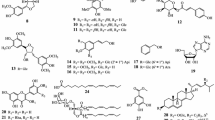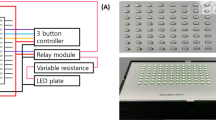Abstract
In this study, the antioxidant potentials of crude extracts and solvent-partitioned fractions of Limonium tetragonum were assessed by measuring their ability to scavenge intracellular reactive oxygen species (ROS) generated in HT-1080 cells. Following activity-oriented separation, four flavonol glycosides were isolated as active principles and their chemical structures were determined by 2 D NMR and by comparison with reported spectral data. The isolated compounds (1–4) were evaluated for their antioxidant capacity using three different activity tests; degree of occurrence of intracellular ROS, lipid peroxidation in HT-1080 cells and the extent of oxidative damage of genomic DNA purified from HT-1080 cells. All compounds exhibited significantly inhibited the generation of intracellular ROS and lipid peroxidation in HT-1080 cells, and significantly inhibited DNA oxidation. In addition, direct free radical scavenging effects of these compounds were investigated using the electron spin resonance (ESR) spin-trap technique.
Similar content being viewed by others
References
Paridaa, A. K. and A. B. Das (2005) Salt tolerance and salinity effects on plants: a review. Ecotox. Environ. Safe. 60: 324–349.
Amor, N. B., K. B. Hameda, A. Debeza, C. Grignonb, and C. Abdellya (2005) Physiological and antioxidant responses of the perennial halophyte Crithmum maritimum to salinity. Plant Sci. 168: 889–899.
Bartosz, G. (1997) Oxidative stress in plants. Acta Physiol. Plant 19: 47–64.
Rout, N. P. and B. P. Shaw (2001) Salt tolerance in aquatic macrophytes: Possible involvement of the antioxidative enzymes. Plant Sci. 160: 415–423.
Gossett, D. R., E. P. Millhollon, and M. C. Lucas (1994) Antioxidant responses to NaCl stress in salt-tolerant and salt-sensitive cultivars of cotton. Crop Sci. 34: 706–714.
Fridovich, I. (1986) Biological effects of the superoxide radical. Arch. Biochem. Biophys. 247: 1–11.
Imlay, J. A. and S. Linn (1988) DNA damage and oxygen radical toxicity. Science 240: 1302–1309.
Ksouri, R., H. Falleh, W. Megdiche, N. Trabelsi, B. Mhamdi, K. Chaieb, A. Bakrouf, C. Magne, and C. Abdelly (2009) Antioxidant and antimicrobial activities of the edible medicinal halophyte Tamarix gallica L. and related polyphenolic constituents. Food Chem. Toxicol. 47: 2083–2091.
Ksouri, R., W. Megdiche, H. Falleh, N. Trabelsi, M. Boulaaba, A. Smaoui, and C. Abdelly (2008) Influence of biological, environmental and technical factorson phenolic content and antioxidant activities of Tunisian halophytes. C. R. Biologies 331: 865–873.
Ben Hamed, K., A. Castagna, S. Elkahoui, A. Ranieri, and C. Abdelly (2007) Sea fennel (Crithmum maritimum L.) under salinity conditions: A comparison of leaf and root antioxidant responses. Plant Growth Regul. 53: 185–194.
Jithesh, M. N., S. R. Prashanth, K. R. Sivaprakash, and A. K. Parida (2006) Antioxidative response mechanisms in halophytes: Their role in stress defence. J. Genet. 85: 237–254.
Kong, C. -S., J. -A. Kim, Z. -J. Qian, Y. A. Kim, J. I. Lee, S. -K. Kim, T. J. Nam, and Y. Seo (2009) Protective effect of isorhamnetin and 3-O-β-D-glucopyranoside from Salicornia herbacea against oxidation-induced cell damage. Food Chem. Toxicol. 47: 1914–1920.
Hansen, M. B., S. E. Nielsen, and K. Berg (1989) Re-examination and further development of a precise and rapid dye method for measuring cell growth/cell kill. J. Immunol. Methods 119: 203–210.
LaBel, C. P., H. Ischiopoulos, and S. C. Bondy (1992) Evaluation of the probe 2′,7′-dichlorofluorescin as an indicator of reactive oxygen species formation and oxidative stress. Chem. Res. Toxicol. 5: 227–231.
Heath, R. L. and L. Packer (1968) Photoperoxidation in isolated chloroplasts. I Kinetics and stoichiometry of fatty acid peroxidation. Arch. Biochem. Biophys. 125: 189–198.
Milne, L., P. Nicotera, S. Orrenius, and M. Burkitt (1993) Effects of glutathione and chelating agents on copper-mediated DNA oxidation: pro-oxidant and antioxidant properties of glutathione. Arch. Biochem. Biophys. 304: 102–109.
Nanjo, F., K. Goto, R. Seto, M. Suzuki, M. Sakai, and Y. Hara (1996) Scavenging effects of tea catechins and their derivatives on 1,1-diphenyl-2-picrylhydrazyl radical. Free Rad. Biol. Med. 21: 895–902.
Rosen, G. M. and E. J. Rauckman (1984) Spin trapping of superoxide and hydroxyl radicals. Methods Enzymol. 105: 198–209.
Cakatay, U., A. Telci, R. Kayali, F. Tekeli, T. Akcay, and A. Sivas (2003) Relation of aging with oxidative protein damage parameters in the rat skeletal muscle. Clin. Biochem. 36: 51–55.
Richter, C. (1987) Biophysical consequences of lipid peroxidation in membranes. Chem. Phys. Lipids 44: 175–189.
Mello, L. D., S. Hernandez, G. Marrazza, M. Mascini, and L.T. Kubota (2006) Investigations of the antioxidant properties of plant extracts using a DNA-electrochemical biosensor. Biosens. Bioelectron. 21: 1374–1382.
Dhalla, N. S., R. M. Temsah, and T. Netticadan (2000) Role of oxidative stress in cardiovascular diseases. J. Hypertens. 18: 655–673.
Harper, M. E., L. Bevilacqua, K. Hagopian, R. Weindruch, and J. J. Ramsey (2004) Ageing, oxidative stress, and mitochondrial uncoupling. Acta Physiol. Scand. 182: 321–331.
Henrotin, Y. E., P. Bruckner, and J. P. Pujol (2003) The role of reactive oxygen species in homeostasis and degradation of cartilage. Osteoarthr. Cartil. 11: 747–755.
Ma, W., M. Wlaschek, I. Tantcheva-Poor, L. A. Schneider, L. Naderi, Z. Razi-Wolf, J. Schuller, and K. Scharffetter-Kochanek (2001) Chronological ageing and photoageing of the fibroblasts and the dermal connective tissue. Clin. Exp. Dermatol. 26: 592–599.
Mathy-Hartert, M., G. Martin, P. Devel, G. Deby-Dupont, J. P. Pujol, J. Y. Reginster, and Y. Henrotin (2003) Reactive oxygen species downregulate the expression of proinflammatory genes by human chondrocytes. Inflamm. Res. 52: 111–118.
Foo, L.Y., Y. Lu, A. L. Molan, D. R. Woodfield, and W. C. McNabb (2000) The phenols and prodelphinidins of white clover flowers. Phytochem. 54: 539–548.
Chung, S. K., Y. C. Kim, T. Yoshiaki, T. Kenji, and N. Masatake (2004) Novel flavonol glycoside, 7-O-methyl mearnsitrin, from Sageretia theezans and its antioxidant effect. J. Agric. Food Chem. 52: 4664–4668.
Kong C. S., Y. A. Kim, M. M. Kim, J. S. Park, J. A. Kim, S. K. Kim, B. J. Lee, T. J. Nam, and Y. Seo (2008) Flavonoid glycosides isolated from Salicornia herbacea inhibit matrix metalloproteinase in HT1080 cells. Toxicol. In Vitro 22: 1742–1748.
Lee, D. Y., H. N. Lyu, H. Y. Kwak, L. Jung, Y. H. Lee, D. K. Kim, I. S. Chung, S. H. Kim, and N. I. Baek (2007) Isolation of Flavonoids from the Fruits of Cornus kousa Burg. J. Appl. Biol. Chem. 50: 144–147.
Conforti, F., G. A. Statti, and R. Tundis (2002) Antioxidant activity of methanolic extract of Hypericum triquetrifolium Turra aerial part. Fitoterapia 73: 479–483.
Cho, E. J., T. Yokozawa, and D. Y. Rhyu (2003) Study on the inhibitory effects of Korean medicinal plants and their main compounds on the 1,1-diphenyl-2-picrylhydrazyl radical Phytomed. 10: 544–551.
Yamazaki, E., M. Inagaki, and O. Kurita (2007) Antioxidant activity of Japanese pepper (Zanthoxylum piperitum DC.) fruit. Food Chem. 100: 171–177.
Heo, H. J., Y. J. Kim, and D. Chung (2007) Antioxidant capacities of individual and combined phenolics in a model system. Food Chem. 104: 87–92.
Yoshimura, M., Y. Akamura, T. Mie, and T. Yoshida (2008) Polyphenolic compounds isolated from the leaves of Myrtus communis. J. Nat. Med. 62: 366–368.
Kong, C. -S., Y. A. Kim, M. -M. Kim, J. S. Park, S. -K. Kim, B. - J. Lee, T. J. Nam, and Y. Seo (2008) Antioxidant activity and inhibition of MMP-9 by isorhamnetin and quercetin 3-O-β-D-glucopyranoside isolated from Salicornia herbacea in HT1080 cells. Food Sci. Biotechnol. 17: 983–989.
Hossein, N., K. E. Mohajjel, and Z. Khadijeh (2010) Free radical scavengers from the aerial parts of Euphorbia petiolata. J. Nat. Med. 64: 187–190.
Piao, M. J., K. A. Kang, and R. Zhang (2008) Hyperoside prevents oxidative damage induced by hydrogen peroxide in lung fibroblast cells via an antioxidant effect. BBA.-Gen. Subjects 1780: 1448–1457.
Liu, Z., X. Tao, and C. Zhang (2005) Protective effects of hyperoside (quercetin-3-o-galactoside) to PC12 cells against cytotoxicity induced by hydrogen peroxide and tert-butyl hydroperoxide. Biomed. Pharmacother. 59: 481–490.
Hayder, N., I. Bouhlel, and I. Skandrani (2008) In vitro antioxidant and antigenotoxic potentials of myricetin-3-o-galactoside and myricetin-3-o-rhamnoside from Myrtus communis: Modulation of expression of genes involved in cell defence system using cDNA microarray. Toxicol. in vitro 22: 567–581.
Poot, M., A. Verkerk, J. F. Koster, and J. F. Jongkind (1986) De novo synthesis of glutathione in human fibroblasts during in vitro ageing and in some metabolic diseases as measured by a flow cytometric method. Biochim. Biophys. Acta 883: 580–584.
Sachindra, N. M., E. Sato, H. Maeda, M. Hosokawa, Y. Niwano, M. Kohno, and K. Miyashita (2007) Radical scavenging and singlet oxygen quenching activity of marine carotenoids fucoxanthin and its metabolites. J. Agric. Food Chem. 55: 8516–8522.
Seo, Y. (2010) Antioxidant activity of the chemical constituents from the flower buds of Magnolia denudate. Biotechnol. Bioprocess Eng. 15: 400–406.
Author information
Authors and Affiliations
Corresponding author
Rights and permissions
About this article
Cite this article
Lee, J.I., Kong, CS., Jung, M.E. et al. Antioxidant activity of the halophyte Limonium tetragonum and its major active components. Biotechnol Bioproc E 16, 992–999 (2011). https://doi.org/10.1007/s12257-011-0213-5
Received:
Revised:
Accepted:
Published:
Issue Date:
DOI: https://doi.org/10.1007/s12257-011-0213-5




